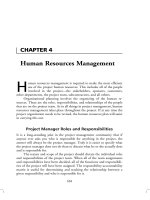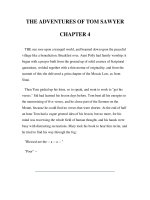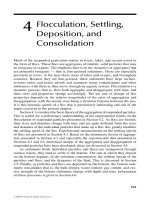Chapter 4 pptx
Bạn đang xem bản rút gọn của tài liệu. Xem và tải ngay bản đầy đủ của tài liệu tại đây (1.33 MB, 59 trang )
© 2012 Cengage Learning. All Rights Reserved. This edition is intended for use outside of the U.S. only, with content that may be different from
the U.S. Edition. May not be scanned, copied, duplicated, or posted to a publicly accessible website, in whole or in part.
© 2012 Cengage Learning. All Rights Reserved. This edition is intended for use outside of the U.S. only, with content that may be different from
the U.S. Edition. May not be scanned, copied, duplicated, or posted to a publicly accessible website, in whole or in part.
Analysis and Design for Systems
9th Edition
Chapter 4
Determining Requirements
© 2012 Cengage Learning. All Rights Reserved. This edition is intended for use outside of the U.S. only, with content that may be different from
the U.S. Edition. May not be scanned, copied, duplicated, or posted to a publicly accessible website, in whole or in part.
Phase Description
•
Systems analysis is the second of five phases
in the systems development life cycle (SDLC)
•
Will use requirements modeling, data and
process modeling, and object modeling
techniques to represent the new system
•
Will consider various development strategies
for the new system, and plan for the
transition to systems design tasks
2
© 2012 Cengage Learning. All Rights Reserved. This edition is intended for use outside of the U.S. only, with content that may be different from
the U.S. Edition. May not be scanned, copied, duplicated, or posted to a publicly accessible website, in whole or in part.
Chapter Objectives
•
Describe systems analysis phase activities
•
Explain joint application development (JAD),
rapid application development (RAD), and
agile methods
•
Use a functional decomposition diagram (FDD)
to model business functions and processes
3
© 2012 Cengage Learning. All Rights Reserved. This edition is intended for use outside of the U.S. only, with content that may be different from
the U.S. Edition. May not be scanned, copied, duplicated, or posted to a publicly accessible website, in whole or in part.
Chapter Objectives
•
Describe the Unified Modeling Language
(UML) and examples of UML diagrams
•
List and describe system requirements,
including outputs, inputs, processes,
performance, and controls
•
Explain the concept of scalability
4
© 2012 Cengage Learning. All Rights Reserved. This edition is intended for use outside of the U.S. only, with content that may be different from
the U.S. Edition. May not be scanned, copied, duplicated, or posted to a publicly accessible website, in whole or in part.
Chapter Objectives
•
Use fact-finding techniques, including
interviews, documentation review,
observation, questionnaires, sampling, and
research
•
Define total cost of ownership (TCO)
•
Conduct a successful interview
•
Develop effective documentation methods to
use during systems development
5
© 2012 Cengage Learning. All Rights Reserved. This edition is intended for use outside of the U.S. only, with content that may be different from
the U.S. Edition. May not be scanned, copied, duplicated, or posted to a publicly accessible website, in whole or in part.
Introduction
•
This chapter describes requirements modeling
techniques and team-based methods that
systems analysts use to visualize and
document new systems
•
The chapter then discusses system
requirements and fact-finding techniques,
which include interviewing, documentation
review, observation, surveys and
questionnaires, sampling, and research
6
© 2012 Cengage Learning. All Rights Reserved. This edition is intended for use outside of the U.S. only, with content that may be different from
the U.S. Edition. May not be scanned, copied, duplicated, or posted to a publicly accessible website, in whole or in part.
Systems Analysis Phase Overview
•
The overall objective of the systems analysis
phase is to understand the proposed project,
ensure that it will support business
requirements, and build a solid foundation for
system development
•
You use models and other documentation
tools to visualize and describe the proposed
system
7
© 2012 Cengage Learning. All Rights Reserved. This edition is intended for use outside of the U.S. only, with content that may be different from
the U.S. Edition. May not be scanned, copied, duplicated, or posted to a publicly accessible website, in whole or in part.
Systems Analysis Phase Overview
•
Systems Analysis
Activities
–
Requirements
modeling
•
Outputs
•
Inputs
•
Processes
•
Performance
•
Security
8
© 2012 Cengage Learning. All Rights Reserved. This edition is intended for use outside of the U.S. only, with content that may be different from
the U.S. Edition. May not be scanned, copied, duplicated, or posted to a publicly accessible website, in whole or in part.
Systems Analysis Phase Overview
•
Systems Analysis Activities
–
Data and process modeling
–
Object Modeling
–
Development Strategies
•
System requirements document
9
© 2012 Cengage Learning. All Rights Reserved. This edition is intended for use outside of the U.S. only, with content that may be different from
the U.S. Edition. May not be scanned, copied, duplicated, or posted to a publicly accessible website, in whole or in part.
Systems Analysis Phase Overview
•
Systems Analysis Skills
–
Analytical skills
–
Interpersonal skills
•
Team-Oriented Methods and Techniques
–
Joint application development (JAD)
–
Rapid application development (RAD)
–
Agile methods
10
© 2012 Cengage Learning. All Rights Reserved. This edition is intended for use outside of the U.S. only, with content that may be different from
the U.S. Edition. May not be scanned, copied, duplicated, or posted to a publicly accessible website, in whole or in part.
Joint Application Development
•
User Involvement
–
Users have a vital stake in an information system
and they should participate fully
–
Successful systems must be user-oriented, and
users need to be involved
–
One popular strategy for user involvement is a JAD
team approach
11
© 2012 Cengage Learning. All Rights Reserved. This edition is intended for use outside of the U.S. only, with content that may be different from
the U.S. Edition. May not be scanned, copied, duplicated, or posted to a publicly accessible website, in whole or in part.
Joint Application Development
•
JAD Participants and Roles
12
© 2012 Cengage Learning. All Rights Reserved. This edition is intended for use outside of the U.S. only, with content that may be different from
the U.S. Edition. May not be scanned, copied, duplicated, or posted to a publicly accessible website, in whole or in part.
Joint Application Development
•
JAD Advantages and Disadvantages
–
More expensive and can be cumbersome if the
group is too large relative to the size of the project
–
Allows key users to participate effectively
–
When properly used, JAD can result in a more
accurate statement of system requirements, a
better understanding of common goals, and a
stronger commitment to the success of the new
system
13
© 2012 Cengage Learning. All Rights Reserved. This edition is intended for use outside of the U.S. only, with content that may be different from
the U.S. Edition. May not be scanned, copied, duplicated, or posted to a publicly accessible website, in whole or in part.
Rapid Application Development
•
Is a team-based technique that speeds up
information systems development and
produces a functioning information system
•
Relies heavily on prototyping and user
involvement
•
Interactive process continues until the system
is completely developed and users are
satisfied
14
© 2012 Cengage Learning. All Rights Reserved. This edition is intended for use outside of the U.S. only, with content that may be different from
the U.S. Edition. May not be scanned, copied, duplicated, or posted to a publicly accessible website, in whole or in part.
Rapid Application Development
•
RAD Phases and Activities
15
© 2012 Cengage Learning. All Rights Reserved. This edition is intended for use outside of the U.S. only, with content that may be different from
the U.S. Edition. May not be scanned, copied, duplicated, or posted to a publicly accessible website, in whole or in part.
Rapid Application Development
•
RAD Objectives
–
To cut development time and expense by
involving the users in every phase of systems
development
–
Successful RAD team must have IT resources,
skills, and management support
–
Helps a development team design a system that
requires a highly interactive or complex user
interface
16
© 2012 Cengage Learning. All Rights Reserved. This edition is intended for use outside of the U.S. only, with content that may be different from
the U.S. Edition. May not be scanned, copied, duplicated, or posted to a publicly accessible website, in whole or in part.
Rapid Application Development
•
RAD Advantages and Disadvantages
–
Systems can be developed more quickly with
significant cost savings
–
RAD stresses the mechanics of the system itself
and does not emphasize the company’s strategic
business needs
–
Might allow less time to develop quality,
consistency, and design standards
17
© 2012 Cengage Learning. All Rights Reserved. This edition is intended for use outside of the U.S. only, with content that may be different from
the U.S. Edition. May not be scanned, copied, duplicated, or posted to a publicly accessible website, in whole or in part.
Agile Methods
•
Attempt to develop a system incrementally by
building a series of prototypes and constantly
adjusting them to user requirements.
•
As the Agile process continues, developers
revise, extend, and merge earlier versions into
the final product.
•
An Agile approach emphasizes continuous
feedback.
18
© 2012 Cengage Learning. All Rights Reserved. This edition is intended for use outside of the U.S. only, with content that may be different from
the U.S. Edition. May not be scanned, copied, duplicated, or posted to a publicly accessible website, in whole or in part.
•
As Agile methods become more popular, a
large community of agile-related software and
services has evolved.
•
For example: Visual Paradigm offers Agilian,
which includes a set of agile modeling tools.
•
The Agilian modeling toolset includes support
for many modeling tools (UML, ERD, DFD,
BFM)
19
Agile Methods
© 2012 Cengage Learning. All Rights Reserved. This edition is intended for use outside of the U.S. only, with content that may be different from
the U.S. Edition. May not be scanned, copied, duplicated, or posted to a publicly accessible website, in whole or in part.
•
Some agile developers prefer not to use CASE
tools at all, and rely instead on whiteboard
displays and arrangements of movable sticky
notes (simple, rapid, flexible and user
oriented)
20
Agile Methods
© 2012 Cengage Learning. All Rights Reserved. This edition is intended for use outside of the U.S. only, with content that may be different from
the U.S. Edition. May not be scanned, copied, duplicated, or posted to a publicly accessible website, in whole or in part.
Agile Methods
•
Scrum is another agile approach.
•
Derived from the rugby term scrum, where
team members prepare to lunge at each other
to achieve their objectives.
•
In Scrum session, agile team members play a
specific roles (pigs or chickens)
•
These roles a based on the old joke about the
pig and chicken who discuss a restaurant
where ham and eggs would be served.
21
© 2012 Cengage Learning. All Rights Reserved. This edition is intended for use outside of the U.S. only, with content that may be different from
the U.S. Edition. May not be scanned, copied, duplicated, or posted to a publicly accessible website, in whole or in part.
•
However, the pig declines, because that role
would require a total commitment, while for
the chicken, it would only be a contribution.
•
Pigs include the product owner, the facilitator,
and the development team; while the
chickens include users, other stakeholders,
and managers
22
Agile Methods
© 2012 Cengage Learning. All Rights Reserved. This edition is intended for use outside of the U.S. only, with content that may be different from
the U.S. Edition. May not be scanned, copied, duplicated, or posted to a publicly accessible website, in whole or in part.
•
Scrum sessions have specific guidelines that
emphasize time blocks, interaction, and team-
based activities that result in deliverable
software
23
Agile Methods
© 2012 Cengage Learning. All Rights Reserved. This edition is intended for use outside of the U.S. only, with content that may be different from
the U.S. Edition. May not be scanned, copied, duplicated, or posted to a publicly accessible website, in whole or in part.
Agile Methods Advantages
Are very flexible and efficient in dealing with
change.
They are popular because they stress team
interaction and reflect a set of community-
based value.
Frequent deliverables constantly validate the
project and reduce risk
24
© 2012 Cengage Learning. All Rights Reserved. This edition is intended for use outside of the U.S. only, with content that may be different from
the U.S. Edition. May not be scanned, copied, duplicated, or posted to a publicly accessible website, in whole or in part.
•
Team members need a high level of
technical and interpersonal skills.
•
A lack of structure and documentation
can introduce risk factors.
•
The overall project may be subject to
significant change in scope as user
requirements continue to evolve.
25
Agile Methods Disadvantages









